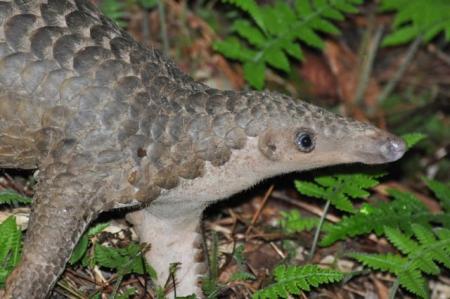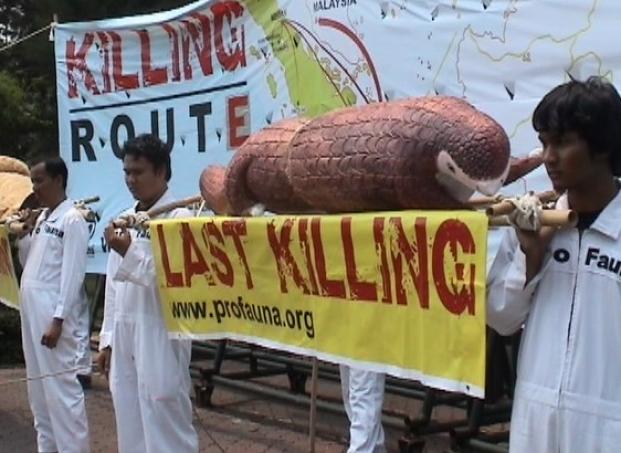Pangolin in Perils: Heinous Myth and Threats
 On 25 August 2016 the Nature Conservation Agency arrested a smuggler of 657 frozen pangolins. The man, SF (55), was seized in Jombang, East Java, before he managed to ship the pangolins to China. He revealed that he was going to sell the poor pangolins for IDR 2 million per kilo, while each pangolin could weigh 5-10 kilos!
On 25 August 2016 the Nature Conservation Agency arrested a smuggler of 657 frozen pangolins. The man, SF (55), was seized in Jombang, East Java, before he managed to ship the pangolins to China. He revealed that he was going to sell the poor pangolins for IDR 2 million per kilo, while each pangolin could weigh 5-10 kilos!
In 2015, South Sumatera Nature Conservation Agency arrested an bigscale pangolin trafficker in Medan, North Sumatera. The authority confiscated and has exterminated 5 tons of frozen pangolins and 77 kilograms of pangolin scales, as well as rescued another 95 live pangolins. However, it was very discouraging when the smuggler, Abeng, was given only 17 months of prison term and IDR 50 million fines, which were nothing compared to the country's loss or ecosystem damage.
The largest wildlife trafficking involving pangolins took place in 2008 in Palembang, South Sumatera, where the authority seized 14 tons of frozen pangolins from a warehouse. The raid was suspected to be closely connected to other smuggling attempts foiled during that time in Vietnam, as local authorities believed that the pangolins came from Indonesia.
What is a Pangolin?
Pangolin is a group of mammals species found in Asia and Africa, including in Indonesia. There are eight pangolin species in the world, but all pangolins in Indonesia have been put into one species, the Sunda Pangolin (Manis javanica), which occur in Sumatera, Java, and Kalimantan. This insectivore is the only mammals that is covered with scales (except for its underside), which functions as an armor. When the pangolin is in danger, it would curl into a ball covered with had scales that even tiger bites could not crack.
Pangolins can be found at sea level up to 1,700 masl, mostly in primary and secondary forests. Until today, information or studies on all pangolin species are still lacking due to their elusive nature and because pangolins is relatively "not as interesting" as other iconic species like tigers, elephants, or rhinos.
Loaded with Myths
For the past few years, the number of researchers putting interest in pangolin has been growing fast because of the mammal's massive international illegal trade to fulfil the demand. What causes the immense demand for this somewhat-ugly creature?
Highest demand for pangolins comes from China, as many Chinese people believe that pangolin meat and organs (especially the scales) has medical benefits to cure various diseases such as skin diseases, altering blood circulation, boosting vitality, improving breast milk, up to curing cancer! Are those true?
Prof. Gono Semiadi from the Indonesian Institutes of Sciences on his statement to the press said that he agrees with many other pharmacologists from all over the world who have studied the content of pangolin meat and scale, and found that there is no special element in pangolin's body which makes it special.
Pangolin meat does not possess a higher nutrients than chicken meat, consisten with consumers' testimony saying that pangolin meat even tastes like chicken. What is more horrenddous, many Chinese people are known to enjoy pangolin fetus on soups, or adult pangolin served alive before being slaughtered right before meal.
Pangolin scales also contain similar elements to our fingernails, but they may worth up to USD 5 per piece (while each pangolin can have approximately 120 scales covering its body!). crazy thing is, pangolin scale is popular in black market to be used in meth industry. This practice is utterly cruel because the scales are sloughed through a boiling process, sometimes when the animal is still alive!
Pangolin began to gain attention in the mid-90s when the demand for live pangolin, meat, and scales skyrocketed. Naturally, pangolins can be found in China, but the population has plummeted and become very rare that they need supply from other countries like Indonesia and Vietnam. Although habitat conversion poses certain danger for pangolin, the animal has been proven adaptable as they can even be found around oil palm plantations.
Although pangolin has an excellent defense mechanism to survive predators like big cats, curling its body into a hard ball makes them even more vulnerable to immoral humans.
Lack of information, segmented market, and uninteresting figure has made protection effort quite difficult for these poor species. Not many individual researchers or organizations pays special attention to this norcturnal animal, not like the "eye candy" orangutan, tiger, or rhino. But that makes matters worse, and pushe pangolin closer to the brink of extinction each day.
Protection
Pangolin has been declared "the most endangered mammal" nowadays. Roughly, there are around 100,000 pangolins captured from the wild each year. This is very saddeing because pangolin only gives birth to one baby at a time. Pangolin population anywhere in the world is still unknown, and so is its age span.
However, experts are positive that whatever the count is, the population in rapidly decreasing and extinction could be near. In 1996, the IUCN gave Low Concern (LC) status to pangolin in Indonesia. On 2008, the convention elevated the status higher up into Endangered category (EN), and got sunk deeper into Critically Endangered (CR) in 2014.
In Indonesia, pangolin is protected by Law no.5 of 1990 concerning the Conservation of Living Natural Resource annd Its Ecosystem, derived into Government Regulation no.7 of 1999 concerning the Preservation of Flora and Fauna.
On 28 September 2016, 183 CITES-member country representatives agreed to include all pangolin species in the world into Appendix I (from previously listed in Appendix II), means that all pangolin species are forbidden for international trade, except for special purposes such as research. The final decision will be made on 8 October 2016. Let us see how it goes, we hope that things will turn out good for the sake of pangolins.

